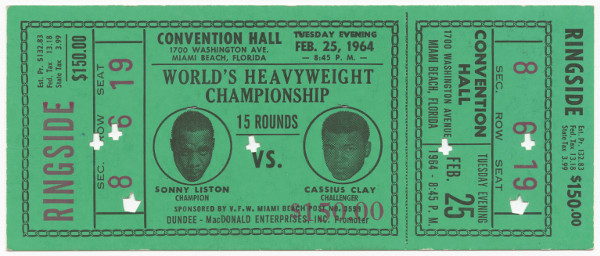Why the Sports Fans in Your Class Will Love D.C.’s New African-American Museum

Ticket for world heavyweight championship boxing match between Sonny Liston and Cassius Clay (later known as Muhammad Ali). Photo courtesy Smithsonian National Museum of African American History & Culture.
The National Museum of African American History and Culture in Washington, D.C. has opened to rave reviews. The praise is justified – as visitors experience African Americans’ journey from slavery to equality, they learn, feel and have fun.
But that doesn’t mean the museum is an automatic winner for every student in a school group visiting the NMAAHC. Some kids just aren’t into museums.
The good news is that the museum is large and multi-faceted – to use a cliché, there’s something for everyone. So today we’ll share one way we believe a teacher or group leader can reach kids who aren’t excited about visiting the Smithsonian’s new African-American museum: Sports.
The museum’s “Leveling the Playing Field” section on Level L3 is full of information and items about African Americans and athletics. A student could have an enriching visit by spending all of his or her time in the NMAAHC sports gallery, in fact – history, culture and social issues are tied together throughout.
Perhaps that shouldn’t be surprising for a museum that opened the same autumn that San Francisco 49ers quarterback Colin Kaepernick decided to take a knee in protest during the national anthem.
His demonstration prompted other athletes to do the same, and it sparked serious discussions about race and politics nationwide.
“I’m not anti-American,” Kaepernick said. “I love America. I love people. That’s why I’m doing this. I want to help make America better. I think having these conversations helps everybody have a better understanding of where everybody is coming from.”
Sports, Civil Rights and Politics Mix
Students might think of Kaepernick’s protest the moment they walk into the NMAAHC sports gallery. Near the entrance they’ll see a statue of Tommie Smith and John Carlos at the 1968 Olympics in Mexico City. Smith and Carlos raised one gloved hand and bowed their heads during the 200-meter medal ceremony. It’s considered one of the bigger political protests of the modern Olympics.
The crowd booed the American duo, who were expelled from the Olympics. Death threats and criticism followed them for years. But Smith insisted that the gesture was a “human rights salute” and not a political Black Power symbol.
Smith and Carlos were among the many athletes to be caught – or to insert themselves – in the intersection of sports, civil rights and politics.
Jesse Owens thwarted Adolph Hitler’s boasts of Aryan supremacy in the 1936 Olympics by winning four gold medals.
Muhammad Ali refused to enlist in the U.S. military because of his Muslim beliefs. He needed a Supreme Court decision to end a three-year ban from boxing and reverse a five-year prison sentence over draft evasion. Ali is shown in the museum with the torch he later used during the opening ceremonies at the 1996 Olympics in Atlanta.
Jackie Robinson was the first African American in Major League Baseball, joining the Brooklyn Dodgers in 1947. His No. 42 is now retired by every team, league wide.
Arthur Ashe was the world’s top-ranked tennis player in the late 1970s. Growing up in Richmond, Va., he wasn’t allowed to play the sport on public courts because of his race.
A Long Way From the Back of the Bus
Althea Gibson played professional golf despite being banned from clubhouses at several courses. She was also the first African-American woman to play international tennis, and she eventually won Wimbledon, accepting the trophy from Queen Elizabeth II.
“Shaking hands with the queen of England,” Gibson said, “was a long way from being forced to sit in the colored section of the bus.”
Sports, of course, is just one piece of the NMAAHC experience. But it shouldn’t be discounted. It offers strong connections between past and present, and shines a light on an area where African Americans have long struggled for equal access and acknowledgement.
And there’s no doubt that athletics can be the backbone of a meaningful visit for any student.
Read more: Leveling the Playing Field, from the official museum website
Julian Tours has produced a free, downloadable guide for educators and others planning a group visit to the new National Museum of African American History and Culture in Washington, D.C. Click below for more information:





